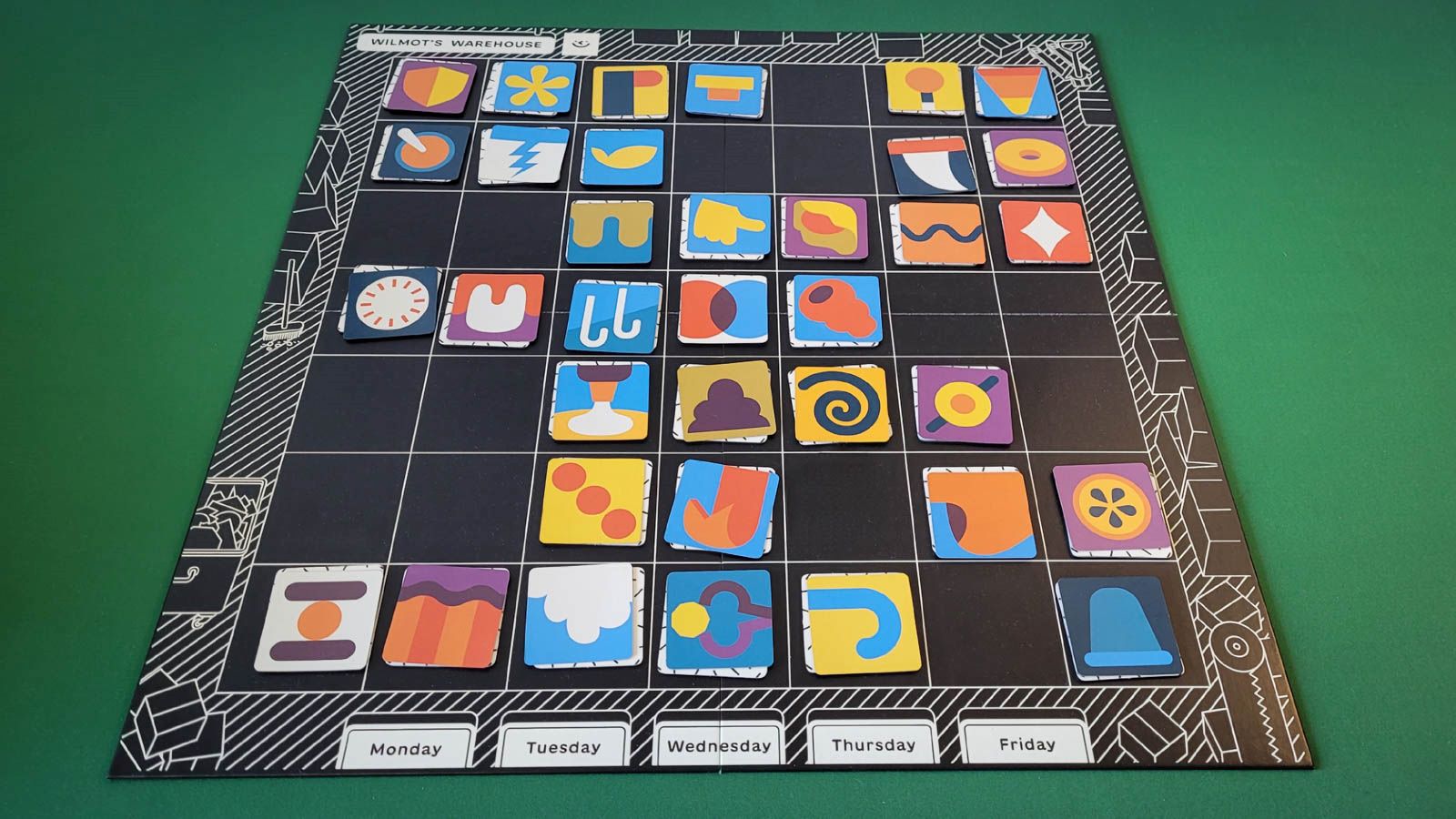Wilmot’s Warehouse Review
Year: 2024 | Players: 2-6 | Min: 30 | Ages: 8+
This Wilmot’s Warehouse review was made after playing the game six times. The publisher sent us a copy of this game in exchange for an honest review.
What is Wilmot’s Warehouse?
Wilmot’s Warehouse is a cooperative memory game in which you work together to organize a warehouse by using memory and creativity to place product tiles, and then scramble to match them with customer orders.
This game is based on the Wilmot’s Warehouse video game, though it’s quite different mechanically.
Wilmot’s Warehouse was designed by Ricky Haggett, Richard Hogg, and David King, and is published by CMYK.
Rules Overview
In Wilmot’s Warehouse, you and your teammates work together to organize a chaotic warehouse filled with products, relying on memory to keep track of where everything goes.
Round Structure
Draw Tiles: Each day, the Shift Supervisor draws one product tile at a time from the day’s stack. The team discusses what each tile looks like to determine the best placement strategy. You can try to remember where the tiles are placed by telling stories, organizing them by themes, or anything else you can come up with.
Place Tiles: After discussing a tile, the Supervisor places it in an open spot in the warehouse. Once placed, the tile is flipped face down and can’t be looked at again for the rest of the game. All tiles must be placed adjacent to previously laid tiles, continuing this process until all seven tiles for the day are placed.
Mandatory Ideas: Starting on Tuesday, a Mandatory Idea card will add unique restrictions or challenges to your tile placements and communication.
Customer Rush
At the end of the week, with all 35 tiles face down in the warehouse, you start a stopwatch and try to find the products your customers need. You divide the customer cards among team members and work together to try to recall where each product was placed.
Your goal is to match the hidden product tiles with customer cards featuring the same art in under five minutes.
Performance Review
You’ll determine how well your team did based on how quickly and accurately you match the customer cards to the product tiles. You’ll also get penalties for any mismatches, which add to your final time.
Pros and Cons
Pros
- One of the coolest things about Wilmot’s Warehouse is that every group’s experience is going to be different. One of my groups loved coming up with stories to connect the tiles, while the other preferred to group them by color and shape. Both approaches were a lot of fun and worked really well.
- I like how the different shapes on the tiles can be interpreted in so many ways. Whether you’re coming up with funny stories or grouping them by patterns, their simplicity opens up a lot of creative possibilities for remembering where they go.
- Wilmot’s Warehouse seems to bring out the creativity in everyone, even if you don’t normally think of yourself as a creative person. It makes group storytelling feel natural and easy, and you’ll find yourself coming up with clever connections without even trying.
- There’s something uniquely satisfying about remembering where all 35 tiles are placed. It’s not just about memorizing the locations; it’s the thrill of knowing that your team’s strategies actually worked.
- I think Wilmot’s Warehouse would’ve been solid even without the Mandatory Idea cards, but those cards take the game to the next level by keeping things fresh and unpredictable. They add just the right amount of challenge and variety.
- I also like how the game was designed to work for gamers of all skill levels. You can explain the rules in about a minute, making it an easy game to bring out at family gatherings, parties, or even with your core gaming group as a filler game to begin the night.
Cons
- I can see the replayability being low for some groups if they’re very good at memory games. Even with the tougher Mandatory Idea cards mixed in, some groups might find the game too easy and breeze through it without much challenge.
- I’ve seen firsthand that the memory aspect can overwhelm some players. If someone struggles to recall where a tile is, it can be frustrating, especially during the final real-time part of the game.
- If one or two players are much better at memory games than the rest of the group, they might end up doing most of the work (quarterbacking). This can be frustrating for everyone else, as it may feel like those players are carrying the team rather than everyone contributing equally.
Final Thoughts
Wilmot’s Warehouse is a unique co-op experience. I typically like memory games but don’t always love them, yet this one worked well for me and the two groups I played it with. The satisfaction of remembering where all the tiles are placed, thanks to the storytelling and other strategies we come up with, turns the memorization element into something truly enjoyable.
I’m not sure yet if Wilmot’s Warehouse has long-term replayability, but for now, it’s a game I look forward to playing again. Hanabi is still my favorite co-op memory game, but Wilmot’s Warehouse isn’t too far behind it.
If you enjoy memory games and your group is pretty evenly skilled, you’ll probably have a blast playing Wilmot’s Warehouse.
- Update: Wilmot’s Warehouse was added to the Best Easy Board Games list!
Wilmot’s Warehouse Links
BGG | Amazon | Asmodee
Thanks for taking the time to read our Wilmot’s Warehouse review!
Be sure to also take a look at our Best Co-op Board Games list and the other board game rankings.
Subscribe to our newsletter if you want more co-op board game content sent right to your inbox!
[Sassy_Social_Share title=”Share this page”]




